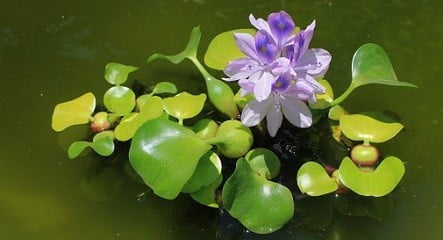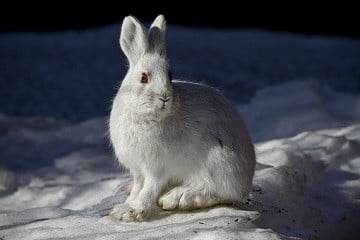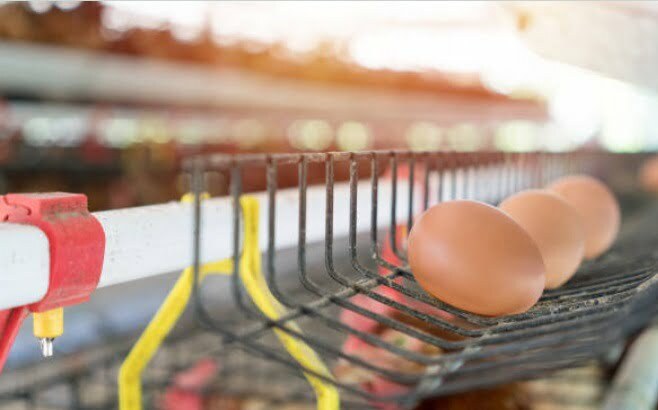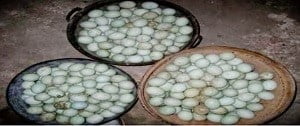Water hyacinth as animal feed can be a good alternative feed for livestock. For example for rabbit, goat, or sheep. In this article, we can see, how we can manage water hyacinth as animal feed. Make it safe and edible.
Could it be, water hyacinth as animal feed?
Who does not know water hyacinth? I think everyone knows.
Plants that grow a lot in the waters are green and float and the amount is very very much. The growth of water hyacinth is also very fast.
Then, whether this plant can be used as ruminants feed, such as goats, sheep, or cows?
30 forage alternatives for goat
I found a research journal that examines the use of water hyacinth plants to feed ruminants.
But the ruminant livestock is not a goat, a sheep, or a cow but a rabbit.
It is okay. Rabbits also include ruminant animals, only smaller.
Maybe later if I find a journal about water hyacinth research to feed goats, sheep or cows I will share it on this blog.
And I found it. the part is at the end of this article.
Well, as a first step, it’s good if I know in advance this hyacinth plant.
Ok, Here is the theory.
Water hyacinth (Eichhornia crassipes Martius (Solms-Laubach) is a perennial or annual water plant, and belongs to the Pontedericeae species, one of the flowering plants of the Amazon basin, South America.
Since the late 1800s, it has spread throughout the world as an ornamental plant in tropical and subtropical countries and warm-tempered countries.
Water hyacinth has the fastest productivity and growth among all aquatic plants, where it can decrease the water ecosystem.
Water hyacinth (Eichhornia crassipes) is generally regarded as a weed that grows in almost all tropical and subtropical waters and grows also in Indonesia.
As weed water, water hyacinth easily adapts to the environment and quickly breeds.
This plant lives floating on the surface of the water or develops its roots in the mud so that in a short time can cover the water surface and result in the decline of the surrounding aquatic ecosystems.
Hyacinth can eliminate the existence of native plants in the waters.
This plant can cause a decrease in oxygen content, cover the entry of light, temperature and change the pH, thus providing harm to the underlying ecosystem.
The existence of water hyacinth certainly there are advantages or disadvantages.
On the other hand, water hyacinth has a favorable potential.
In addition to its existence that is considered as waterweed, on the other hand, it can contribute to absorbing toxic heavy materials in the water, making art paper, a raw material of plant fertilizer, and as animal feed.
Water hyacinth also has advantages, as in leaves that contain higher calcium than the stems and roots.
The high content of kalisum is useful to neutralize organic acids from metabolism (such as oxalic acid) which is toxic to livestock.
In addition, it is reported also in water hyacinth leaves enriched with a high carotene content of about 109,000 IU / 100 grams.
Another advantage of water hyacinth is that it contains nutrients that can be utilized as alternative feed ingredients of livestock because of the content of carotenoid pigments, especially pigments β-carotene and xantofil.
However, the use of water hyacinth as feed ingredients has several disadvantages.
The disadvantages include:
high water content, smooth texture, contains many hemicelluloses and proteins are difficult to digest.
This needs to be done beforehand in the use of water hyacinth in both physical processing, chemical, biological, and combinations.
One way of biological processing is by making silage.
The silage process is done in an effort to increase protein content, reduce fiber and improve digestibility.
Making Silage water hyacinth is expected to increase the nutrient content in water hyacinth, such as increasing the content of crude protein and reduce the content of crude fiber.
Water Hyacinth Safe For Rabbit Feed
In this study, the livestock used is not a goat, cow, or sheep but a rabbit.
But it does not matter, rabbits are also farm animals and can produce something. Produce meat, urine droppings and others.
Water hyacinth that will be used as a ration material should not be mixed directly.
If you want to try given directly is also okay, if the rabbit is hooked and wants to hehee …
According to this research journal, water hyacinth has a protein content that is difficult to digest.
Therefore, giving water hyacinth to livestock should also not be excessive.
The poor quality of animal feed usually has an effect on the growth of unsatisfactory weight.
Water hyacinth in this research is suggested to make silage first.
The goal is to make water hyacinth more qualified to be used as ration material/animal feed.
The quality of protein, fiber, digestibility and so on become better and efficient.
Hyacinth will be used as a complete mixture of rations.
That is, ration or feed given to the rabbit consists of various kinds of feed ingredients, one of them water hyacinth.
Still, the name of the research should be able to know the result differences of feed that existing of water hyacinth and feed that no water hyacinth.
Rabbits in this study were fed a complete ration (complete composition ration not mentioned).
Some rabbits are fed a pure ration complete. It means no hyacinth at all.
Several other were fed a complete ration of water hyacinth as much as 20%.
Several other, rabbits fed a complete ration with 40% water hyacinth content.
The result is….
The results that can be known in research on the use of water hyacinth as animal feed is the level of ration consumption.
In the table below can be seen the level of consumption level.
R0 is a rabbit feed ration that has no water hyacinth.
R1 is rabbit feed ration that there is water hyacinth 20% and R2 is rabbit feed ration that there is eceng gondoknya 40%.
The result is positive. The highest level of ration consumption was found in feed ration which contained water hyacinth as much as 20% that is 205.82 gram/day.
This is the average value.
The explanation is as follows.
“The addition of water hyacinth into the ration provides a good flavor on the ration thus increasing palatability and affecting the consumption of the ration.
Provision of fermented rations can increase consumption of New Zealand White rabbit rations.
|
Repetitions |
Ration Consumtions (grams/day) |
||
| R0 | R1 | R2 | |
|
1 |
141.89 | 198.15 | 196.2 |
|
2 |
151.5 | 204.02 | 193.48 |
|
3 |
150.89 | 210.87 | 184.46 |
|
4 |
147.72 | 210.22 | 194.46 |
|
5 |
149.02 | 205.39 | 191.17 |
|
6 |
147.5 | 206.28 | 193.17 |
|
Total |
888.52 | 1234.93 | 1152.93 |
|
Averages |
148.09 | 205.82 | 192.15 |
In addition to the level of ration consumption, from this study can also be seen the increase in weight of the rabbit.
The addition of water hyacinth into the ration can improve the quality of the ration so that it can increase the weight gain of livestock.
The results can be seen from the table below. In the table can be seen the numbers as well.
Rabbits fed a complete ration of pure R0, with no hyacinth at all, the average body weight gain during the study was 10.43 grams/day.
Rabbits fed a complete R1 diet, complete ration with 20% water hyacinth content, average body weight gain during the study was 16.22 grams/day.
Rabbits fed a complete ration R2, complete ration with 40% water hyacinth content, average body weight gain during the study was 11.08 grams/day.
|
Repetitions |
Weight Gain (grams/day) |
||
| R0 | R1 | R2 | |
|
1 |
7.6 |
21.31 |
19.8 |
|
2 |
13.13 |
15.82 |
4.56 |
|
3 |
12.78 |
14.71 |
7.78 |
|
4 |
9.78 |
10.82 |
10.71 |
|
5 |
9.76 |
18.14 |
11.79 |
|
6 |
9.54 |
16.53 |
11.87 |
|
Total |
62.59 |
97.34 |
66.5 |
|
Averages |
10.43 |
16.22 |
11.08 |
The amount of water hyacinth is too high, resulting in the amount of anti-nutrients present in the ration is also high.
Anti-nutrients that exist in water hyacinth are oxalic acid, cyanide acid, and nitric acid.
Oxalate is one of the non-polysaccharide components of plant cell walls that can bind minerals such as calcium, magnesium, sodium, and potassium.
This leads to a decrease in consumption so that the highest body weight gain is in mixing R1 rations and declining again as the amount of fermented water hyacinth on R2 rations.
Water hyacinth as animal feed for sheep
In this research, water hyacinth is focused to be used as sheep feed.
During the study, sheep were fed with concentrate, elephant grass, and a complete ration of hyacinth silage.
Concentrates which used maybe commercial concentrates that sold in the market. In the journal just mentioned concentrates only, for the composition is not mentioned.
The forages used during the study were elephant grass.
Hyacinth is presented in a complete ration. Complete ration for sheep feed here is water hyacinth mixed with ingredients of concentrate.
To know the success of water hyacinth as a feed ration of sheep, in this study the sheep were fed a variety of rations.
Simply put, the Sheep are grouped into three groups.
One group was fed a concentrate ration and elephant grass.
The second group of sheep was fed a complete ration of water hyacinth. The water hyacinth is silaged without the addition of a bacterial starter.
The third group, sheep fed a complete ration of water hyacinth which it silaged with the addition of a starter or bacteria.
The bacteria used in the silage of water hyacinth is lactic acid bacteria, L. Plantarum.
Just for information, the nutritional content of the feed sheep ration used can be seen in the table below.
In the table, there is information on the content of dry matter, crude protein, and so on until BETN (extract material without nitrogen).
T0 is the first group feed ration of concentrate and elephant grass.
T1 is the second group feed ration. This ration has a water hyacinth that is silaged without the addition of a starter.
T2 is the third group feed ration. This ration has a water hyacinth silaged with the addition of L. Plantarum bacteria.
| Nutritions |
T0 (%) |
T1 (%) |
T2 (%) |
| Dry Matter |
35.68 |
30.15 | 30.66 |
| Crude Protein |
12.97 |
13.31 | 13.53 |
| Crude Fiber |
25.14 |
24.74 | 25.15 |
| TDN |
64.82 |
65.12 | 66.22 |
| Fat |
6.11 |
5.51 | 5.60 |
| Ash |
11.51 |
11.21 | 11.40 |
| BETN |
44.27 |
45.27 | 44.32 |
The result is ….
Let’s just go to the results of his research.
The results that I will convey here may not be entirely.
The results of this study are the first consumption level of the sheep ration that can be seen in the picture table below.
The table shows that the consumption of dry matters for the T0 ration was 678.27 grams/head/day, T1 was 811.43 grams/head/day and T2 was 701.21 grams/head/day.
This shows that the addition of silaged water hyacinth does not negatively affect the palatability of the ration.
According to the data, sheep that fed with rations without water hyacinth (T0), ration consumption even the least.
The addition of water hyacinth into the complete ration actually gives a good effect that is preferred by sheep.
From the table below, the feed ration added with silaged hyacinth, consumption level is higher than the T0 ration.
However, the silage of water hyacinth with L.plantarum addition was less effective.
This is because the level of complete ration consumption decreases compared to T1 rations.
|
Variable |
Ration consumption and digestibility | ||
| T0 | T1 | T2 | |
| Ration consumption | |||
| Dry Matter (g/day/head? |
678.27 |
811.43 |
701.21 |
| Organic Matter (g/day/head) |
610.79 |
704.35 |
614.90 |
| Dry matter (% Body Weight) |
3.41 |
4.2 |
4.3 |
| Ration digestibility | |||
| Dry matter |
70.51 |
71.74 |
69.82 |
| Organic matter |
72.59 |
73.75 |
71.45 |
The explanation is like this.
The addition of starter bacteria on the silaged water hyacinth will make the water hyacinth silage condition becomes more acidic.
Because it is more acidic, the smell of hyacinth silage will be more sting.
Because it is more stinging, it is less favorable to livestock so that sheep consumption of this ration is less than the ration of silaged water hyacinth without the addition of a bacterial starter.
Not only at a better level of consumption, but the digestibility of rations with the addition of silaged hyacinth is also higher.
This information is also in the table above. The higher the digestibility value of a ration, the higher the nutrients from the rations that can be used by the sheep.
So, if the farmers want to try to use water hyacinth as the ingredients of ration, they should silage the water hyacinth and do not need to add a starter or other bacteria.
References:
Ekawati, Eni, Anis Muktiani, Sunarso. Efficiency and digestibility feed of sheep given silage complete feedwater hyacinth added starter lactobacillus plantarum. 2014 Agripet : Vol (14) No. 2 : 107-114.
Phioneer, Hurin Ria, Husmy Yurmiati, Sauland Sinaga. 2015 LEVEL OF ECONG GONDOK (Eichhornia crassipes) USE IN COMPLETE RANSUM SILAGED ON ADDITIONAL WEIGHT OF AGENCY AND EFFICIENCY RANSUM KELINCI RANSUM NEW ZEALAND WHITE. Faculty of Animal Husbandry. Padjadjaran University
 JOYNIM FARM Goat Farming, Cattle Farm, Laying Hens, Quail Farm, Gardening
JOYNIM FARM Goat Farming, Cattle Farm, Laying Hens, Quail Farm, Gardening




